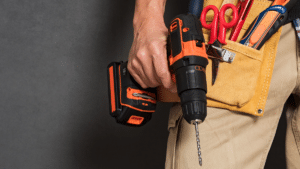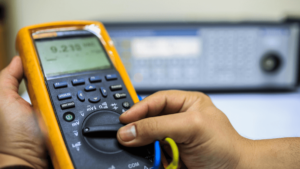Losing track of tools might seem minor, but it quickly adds up in terms of wasted time, eroded trust, and replacement costs.
Most small tools won’t need GPS trackers themselves, but smart tracking systems can still pinpoint their location using scans, tags, and GPS-enabled hubs.
In this article, we’ll break down six of the best GPS-based systems to help you keep tools visible, secure, and accounted for.
In this article...
GoCodes Asset Tracking
Our comprehensive asset management solution, GoCodes Asset Tracking, is tailored for construction professionals.
Built for simplicity and rugged field use, the system combines GPS trackers, QR code labels, and Bluetooth beacons to offer a reliable, cost-effective tool tracking solution.
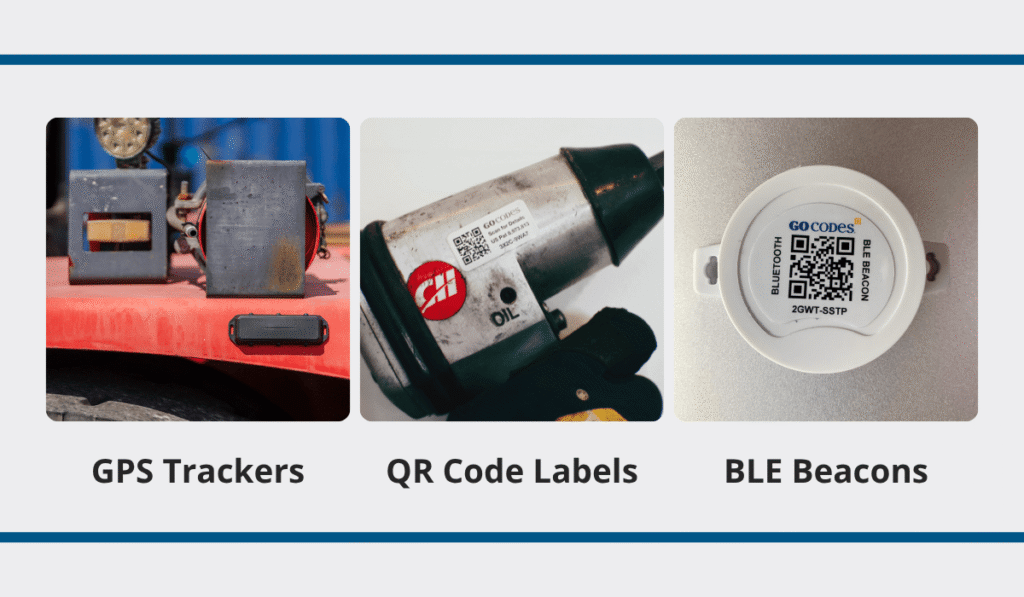
Source: GoCodes Asset Tracking
For high-value or mobile assets, GoCodes Asset Tracking offers GPS trackers with a 10-year battery life, enabling you to track real-time movement across jobsites or between locations.
As you can see below, you can effortlessly track asset movement and incoming shipments along established routes using a single intuitive dashboard.
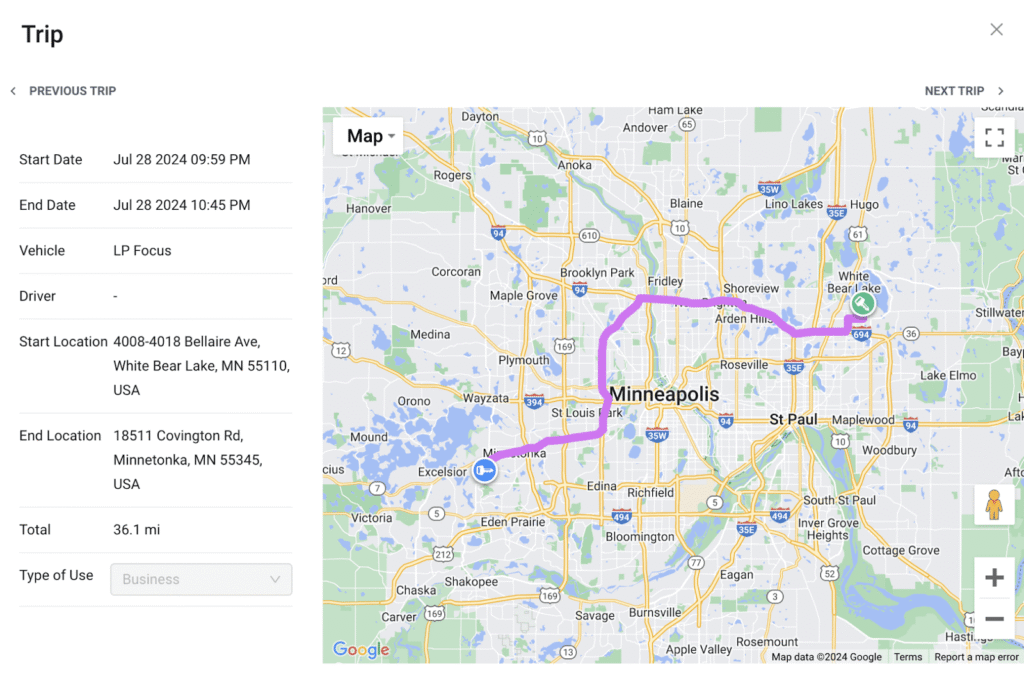
Source: GoCodes Asset Tracking
However, the system offers much more than location tracking.
GoCodes Asset Tracking’ advanced telematics help owners and fleet managers monitor driver behavior and ensure optimal asset condition.
Moreover, geofencing capabilities add an extra layer of security by letting you create custom virtual boundaries.
If your equipment leaves its assigned area, you get an immediate alert.

Source: GoCodes Asset Tracking
You can easily configure specific alert triggers, just keep in mind that real-time GPS tracking only applies to GPS-tagged assets.
Still, assigning unique identifiers and using GPS-enabled QR-code scanning enhances efficiency and on-site accountability.
A simple scan with any smartphone or tablet device enables your crew to reserve and check out tools, check their last location, and access manuals or service records instantly.

Source: GoCodes Asset Tracking
The labels themselves are durable enough to withstand the toughest construction environments.
You can also generate detailed reports, from tool utilization by project to audit-ready asset logs and maintenance schedules, as well as track and assign service tasks.
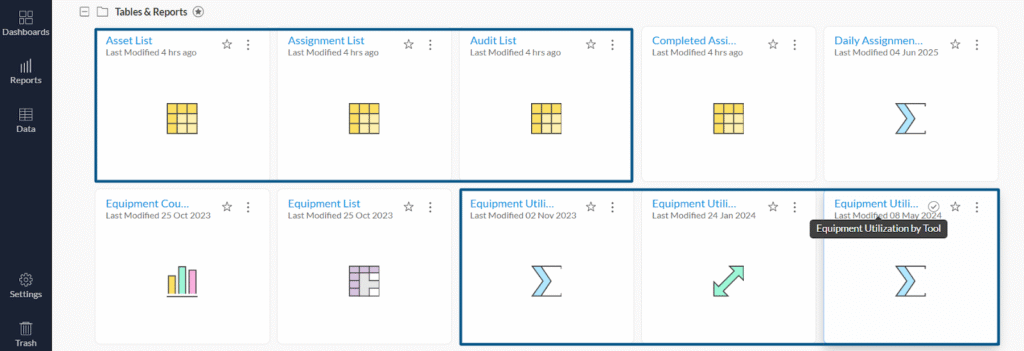
Source: GoCodes Asset Tracking
With all these features, you probably expect the pricing to be sky-high.
However, GoCode’s pricing starts at an affordable $500/year, with clear, transparent tiers that outline exactly what’s included.

Source: GoCodes Asset Tracking
Each subscription includes full access to customer support, training materials, and a 15-day free trial—so you can explore the system risk-free.
All in all, if you’re looking for a practical solution to streamline tool tracking and more, GoCodes Asset Tracking is user-friendly, highly flexible, and sure to deliver long-term value.
Digital Matter
Digital Matter stands apart from the other solutions on this list for a good reason.
Unlike full software suites, it focuses exclusively on delivering GPS and Bluetooth tracking hardware, trusted by major platforms and businesses.
The company’s battery-powered trackers are designed for reliable tracking in all environments, as explained in the video below.
Source: Digital Matter on YouTube
Whether you need to track tools moving between jobsites or monitor high-value equipment in storage, Digital Matter’s devices offer global connectivity, ultra-long battery life, and IP68-rated durability.
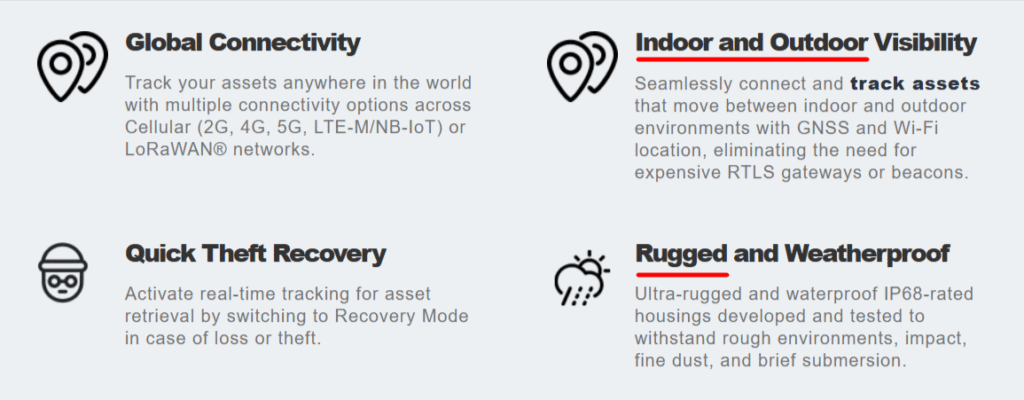
Source: Digital Matter
Notably, these are the same GPS units used by GoCodes Asset Tracking to power the system’s real-time tracking features, which confirms their versatility and suitability for construction and similar sectors.
In addition to GPS, Digital Matter offers Bluetooth gateway devices, which are ideal for monitoring smaller tools or pallets where full GPS tracking isn’t cost-effective.
These gateways detect nearby Bluetooth tags and relay their location, enabling broader visibility without the cost of full-scale GPS.
You can set it all up using their Device Manager platform, which provides remote configuration, performance monitoring, and system health insights.
Keep in mind that Digital Matter’s focus is purely on hardware, which means you won’t find built-in tools like maintenance scheduling or depreciation reporting.
However, its hardware integrates easily with third-party platforms through flexible APIs and an extensive knowledge base.

Source: Digital Matter
Pricing is quote-based, tailored to your needs via direct consultation.
Individual tracker pricing, such as the Yabby Edge, is visible through resellers.

Source: TrackLogix
For those who want top-tier GPS tracking hardware with integration freedom, Digital Matter is a solid choice.
ABAX
ABAX offers a smart asset tracking solution that balances hardware reliability with simple software features built into its ecosystem.
The suite incorporates fleet management and inventory management modules, but the ABAX Locator lies at the heart of the offering.
The system is powered by compact GPS trackers, which are small enough to fit ladders, toolboxes, and other mid-sized assets.

Source: ABAX
The self-installation process is quick and intuitive, allowing teams to deploy tracking without major disruptions.
However, unlike most of the trackers on this list, the battery life caps at around five years, depending on settings and use.
In terms of features, ABAX supports easy asset search and recovery, allowing you to flag a tool as lost and receive a notification as soon as it pings at a new location.

Source: ABAX
This helpful anti-theft measure doesn’t require a third-party setup.
Like GoCodes Asset Tracking, ABAX also supports geofencing, including zone-specific alerts and theft notifications.
The geofence interface is intuitive and can be customized to a jobsite’s boundaries.
Source: ABAX UK on YouTube
As mentioned previously, companies can easily expand into fleet, machine, and inventory management, and centralize some of their operations.
However, this is also where ABAX shows limitations.
For instance, MINI2 BLE trackers rely on ABAX-installed IoT gateways, restricting flexibility and compatibility with other systems.
So, if you’re hoping to integrate with third-party platforms or tailor your tracking setup, ABAX may feel more closed off.
Additionally, this broad, one-size-fits-all approach, along with the absence of dedicated check-in/check-out features, makes it harder to tailor the system to construction workflows.
ABAX pricing isn’t readily available, but you can receive a customized quote based on key service types and the number of assets you want to track.

Source: ABAX
To sum up, companies looking for a compact, ready-made GPS tracking system with theft protection should consider this solution, even more so if they’re already using ABAX products.
itemit
itemit is a user-friendly asset tracking platform built around QR code-based tagging and streamlined equipment checkouts.
From tool reservations and maintenance alerts to issue logging and audits, it’s designed to give teams visibility and control with minimal friction.
The tagging process is intuitive, as shown in itemit’s tutorial video, which makes it ideal for teams looking to digitize tool tracking quickly without overwhelming their workflows.
Source: itemit on YouTube
Assets can be managed from a central dashboard that supports different views, filters, and one-click actions for everyday tasks.
The system incorporates a standard set of features that enable streamlined equipment checkouts and bookings.
The analytics are modest, but notifications and activity summaries, such as spikes in usage or unreturned tools, add a useful layer of visibility.

Source: itemit
Itemit supports a variety of tracking technologies, including QR codes, barcodes, RFID tags, and GPS asset tags with geofencing.
However, there’s very limited public information about itemit’s GPS tracker specifications.
The product pages provide descriptions of essential functionalities, but key details like battery life, connectivity type, or refresh intervals are absent.
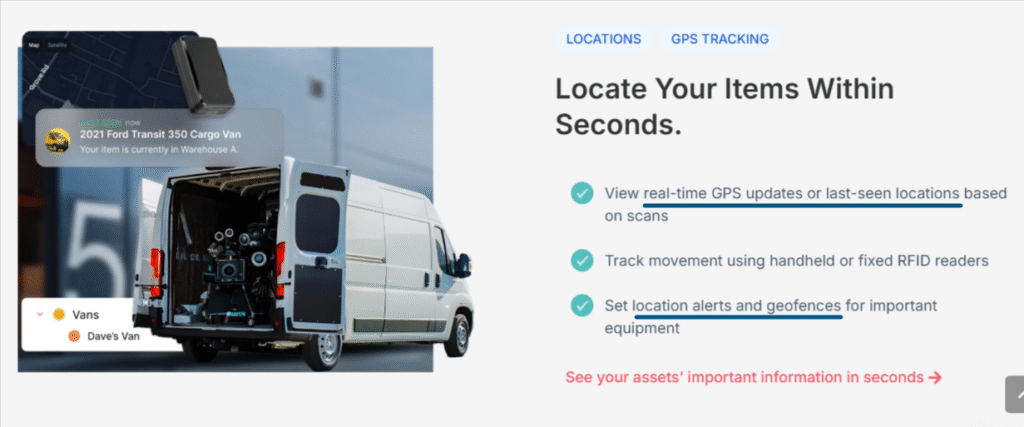
Source: itemit
That may be fine if GPS is an optional feature in your tracking strategy, but when you’re looking for a GPS-centric solution, this lack of transparency might be a drawback compared to other systems on this list.
On a more positive note, itemit’s mobile app earns consistently high reviews, suggesting a smooth user experience even among field teams that are just getting started with digital tracking.
Pricing starts at $599/year per user for up to 1,000 assets, but GPS functionality and unlimited users are only available in the higher-tier Pro and Industrial plans.
Also, GPS trackers are acquired as add-ons.

Source: itemit
Ultimately, companies with light GPS requirements that need a mobile-first tracking system with reliable QR scanning may find everything they need in itemit.
Linxup
Linxup is a GPS tracking provider built with a broad set of industries in mind, from construction and transport, to landscaping, restoration, and delivery.
It offers dedicated solutions for fleet tracking, asset tracking, and tool or light equipment monitoring, making it one of the more versatile platforms on this list.
The platform supports a range of GPS trackers, including options with solar power, rugged weatherproof casings, and long battery life.

These combine with Bluetooth tags for short-range location visibility, and specifically tool tracking, as explained in the video below:
Source: Linxup on YouTube
Although the system lets you track various tools and equipment, there is little information available about this specific tracker model or its impact on productivity and accountability.
Instead, the dashboard and mobile apps are geared toward real-time location tracking, usage data, and behavior monitoring.
You can set custom geofences, receive alerts on unauthorized movement, track idling, and even schedule maintenance tasks from a single platform.

Source: Linxup
Although color-coded elements are intended to boost usability and simplify navigation, the level of detail on the screen can complicate things.
This is especially evident with the reporting tools, where recorded usage patterns and fleet activity are difficult to interpret at a glance.

Source: Linxup
Nevertheless, businesses won’t have to worry about safety and compliance thanks to another optional add-on, AI-powered dashcams, which offer live video uploads, driver behavior tracking, and event-triggered alerts.
With all these extra options, it’s no wonder user reviews emphasize Linxup’s fleet tracking capabilities and reliable hardware.

Source: Capterra
Still, some warn about data limitations and frequent pricing changes as the software’s key downside.
When it comes to pricing, Linxup charges $99 per month for unlimited trackers, plus a one-time fee of $30 per tracker.
Note that this tool tracking add-on requires a Linxup GPS vehicle tracking unit and an active monthly service plan.

Source: Linxup
Overall, if you want basic visibility into tools and equipment, along with robust fleet monitoring, Linxup is another smart tool to consider.
geoCapture
The final solution on our list, geoCapture, is a GPS and business operations platform with tools for construction, logistics, field service, and local government work.
It includes familiar tracking options like GPS and Bluetooth beacons, which are linked to a centralized asset database shown below.
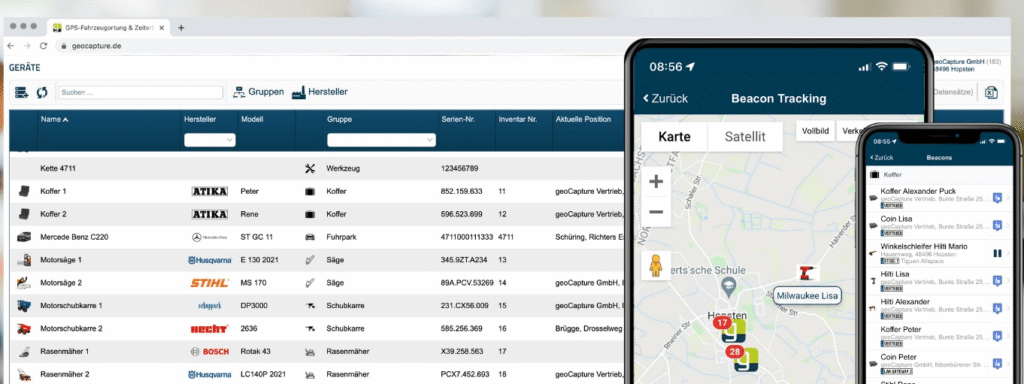
Source: geoCapture
One of geoCapture’s key advantages is its unique modules for time tracking, documentation, and project oversight.
GPS-powered time recording lets field employees clock in/out via GPS vehicle transmitters or mobile RFID cards.
The system also links these work hours to specific jobsites and feeds them into payroll.

Source: geoCapture
Even though its interface feels slightly outdated compared to others, its functionality is modern and modular.
You can also log hours using the geoCapture mobile app, though its primary use is time tracking and documentation, rather than tool checkouts or small asset management.
For site documentation, geoCapture offers an AI-powered construction log that automatically generates daily reports from tracking data.
Crews can add photos, forms, and notes directly from the app, as shown below.
Keep in mind that many resources like this video are exclusively in the German language, which can deter users from other regions.
Source: geoCapture GmbH on YouTube
Since geoCapture uses open GPS trackers, you can reuse them with other systems or resell them later, which is a welcome change in an often closed market.
Additionally, geoCapture won’t confine you to long-term contracts, but the lack of transparent pricing and add-ons can make cost planning somewhat tricky.
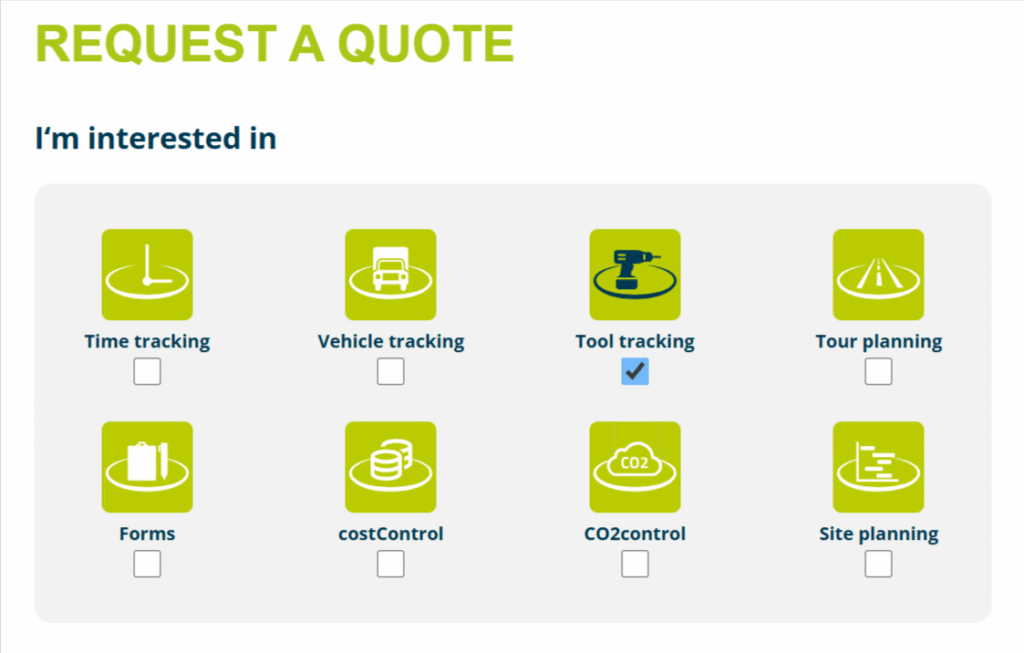
Source: geoCapture
Still, if your business would benefit from a flexible GPS tracking system that features strong documentation and time-logging tools, reaching out is worth it.
Conclusion
And that brings us to the end of our list.
While most tool tracking solutions rely on cloud platforms and GPS-powered tagging, their focus can vary significantly.
Some prioritize location visibility to boost accountability and prevent theft, while others emphasize asset lifecycle management and advanced analytics.
The best fit depends on your budget, workflows, and how your team operates in the field.
So, take the time to compare options and try demos.
That way, you will choose a system that works in practice, not just on paper!









